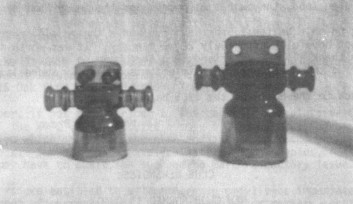Foreign Insulators
by Marilyn Albers
Reprinted from "INSULATORS - Crown Jewels of the Wire", June 1984, page 4
A NEW CROSS BREED FROM FRANCE
Just feast your
eyes on these two new foreign insulator finds! Have you ever seen anything more
fantastic? The smaller insulator on the left is of aqua glass and is embossed
Folembray No. 287. It belongs to Andrew Gibson of Rochester, New York. Andrew
brought it back from France, where he spent the summer of 1983 participating in
an American Teenage Diplomat Student Exchange Program. He was riding horseback
down a road near the town of St. Flour (Central France) when he spotted it very
firmly attached to an upended metal tower lying on the ground. He had to come
back later with a hacksaw in order to claim his prize! In all, he was able to
bring back about 25 different French insulators for his collection in glass,
plastic and porcelain. However, this particular one he felt was his best
discovery! I can certainly see why!
 |
C.D. 687
Folembray No. 287
4-5/8 x 4-1/4 |
C.D. 688
Folembray No. 288
5 x 5-3/9 |
At about the same time that summer, Marshall
Eiserer of San Antonio, Texas, was traveling in northern France. He spotted a
similar insulator attached to a power pole near the city of Nancy. How he was
able to acquire it is his secret alone, but at any rate, it is now in my
collection. In the photo you'll find it on the right side. It is a bit taller
and is made of yellow green glass. The embossing reads Folembray No. 288.
These
insulators appear to be a cross between two typical French designs in that they
have the cock's comb with two "through" holes of a fuse insulator, as
well as the two extended arms of the "T-Bar" insulator. Both, when
they were found, were cemented onto metal pins. According to Marshall, several
examples of this same style of insulator were found attached to the sides of
buildings, carrying wires of positive and negative current, but at the same time
serving as fuse insulators, so that in case of a power surge or some other
electrical disturbance, the building would not burn down! Threaded copper bolts
went through the holes in the glass to hold the wires in place. The copper bolts
are still visible in the smaller insulator. That's why you can't see daylight
through the holes! What a thrill it was to see these two unique insulators for
the first time, We know of no others in collections out there. If you have one,
please write and let me know, so we can catalogue it. Notice the new C.D.
numbers assigned to each of these.
Unfortunately, we still have no definite
information about Folembray, the French glass company that manufactured these
insulators. However, one thing is certain: many styles were offered by
Folembray, ranging all the way from their No. 275 (C.D. 558), which is a mere
3" tall, to the imposing No. 416 (C.D. 370.9), which stands 16-1/2"
high, and, with its three cemented skirts, tips the scales at 37 pounds!
Marshall brought back several other insulators from France, and out of that
batch, we were able to assign about 27 new C.D. numbers. Thanks, Marshall, for
all your efforts, and, Andrew, I appreciate your trusting me with your precious
insulator long enough to take pictures and make shadow drawings. Due to my
involvement in NIA work (rewarding!) during the past two years, I've had to put
aside any work on an update version of Glass Insulators from Outside North
America. So much new material, and the file is bulging! Perhaps, by the time you
read this article, I will already have begun.
|
